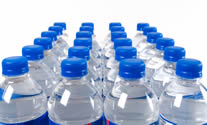
07 Jul Bottled Water
DID YOU KNOW
Why pay almost 2,000 times more per litre buying bottled water than you would if you bought a good water filter and stored it in a stainless steel or glass bottle.
There are several concerns I have about bottled water:
- Source of water – bottled water comes from either a natural source such as a spring or well OR from an approved potable municipal supply (tap water). History shows that natural sources are susceptible to periodical contamination from pollutants generated from agriculture (pesticides, fertilisers, and nitrates), industrial contaminants, algae blooms and bacterial issues. Despite this, bottled water companies are not obliged to regularly test or disclose these contaminants to consumers. In contrast there are strict guidelines for the testing and treatment of tap water.
- Microbial growth – apart from the bottles themselves, a concern associated with the reuse of bottled water is that the sputum harbours bacteria that can grow in the plastic itself. As such, it is critical that you do not reuse plastic PET water bottles. Plastics that don’t pose a health risk that can be reused (refer to plastic bottles below) should be washed in hot soapy water and dried thoroughly with every use.
- Environmental waste – if the water quality issue is not enough to get you to avoid plastic water bottles, then the environmental impact should. Disposable plastic water bottles are derived from a non-renewable source (oil), and have a high embodied energy as the fossil fuels required to produce, recycle and transport them is enormous. Despite manufacturer’s assurances that their bottles are biodegradable, the reality is that more than 90% ends up in landfill or in our waterways. In fact bottled water accounts for almost 38% of general waste! Furthermore these ‘biodegradable” bottles can take hundreds of years to breakdown.
- Plastic bottles– plastics can be differentiated by the resin identification code at the bottom of the bottle. The problem with plastics is that they may contain a range of additives and non-intentionally added substances (NIAS) that provide it with varying properties such as heat resistance, hardness, flexibility, resistance to degradation and transparency which are not evident by the recycling number. Consequently a plastic bottle can be made from a variety of copolymers and still legally be marketed as only having one type of plastic. Polyethylene terephthalate (PET or PETE) ie the #1 is the most commonly used plastic for disposable water bottles and soft drinks because it is the most recyclable. It breaks down readily when exposed to heat and UV, when the water is carbonated or if it contains bacteria (this may come from saliva when you reuse it) which is why PET bottles should never be reused. Unlike other forms of PET packaging, PET water bottles contain non-intentionally added substances (NIAS) which contaminate the bottled water. Up to 80 contaminants have been identified including formaldehyde, acetaldehyde, antimony, trace metals and so on (Bach et al, 2013). Whilst phthalates or other softening additives are not used in the manufacture of PET, there is evidence to suggest they may leach into the water causing a weak oestrogenic like / anti androgenic effect if they have been recycled from personal care products (Wagner and Oehlmann, 2009; Pinto and Reali, 2009; Montuori et al, 2008). Another concern with PET bottles is the presence of the heavy metal antimony which may leach if the bottle is exposed to high temperatures of 60 degrees Celsius or more such as during summer inside a car, garage or storage space (Westerhoff et al, 2008). Antimony in drinking water may lower blood sugar and increase blood cholesterol (US Environmental Protection Agency, 2009).
Want to learn more?
- Step 1: Read Chapter 5: Drinking Water in the Healthy Home Healthy Family book
- Step 2: Enrol in the Drinking Water course
- Step 3: Consider a career as a Building Biologist
References
Bach C, Dauchy X, Severin I, Munoz J, Etienne S, Chagnon M. 2013. Effect of temperature on the release of intentionally and non-intentionally added substances from polyethylene terephthalate (PET) bottles into water: Chemical analysis and potential toxicity. Food Chemistry, 139: 672–680.
Bijlsma, N. 2012. Healthy Home Healthy Family. Joshua Books.
Montuori, P., Jover, E., Morgantini, M., Bayona, J. M., & Triassi, M. (2008). Assessing human exposure to phthalic acid and phthalate esters from mineral water stored in polyethylene terephthalate and glass bottles. Food Additives and Contaminants, 25(4), 511–518.
